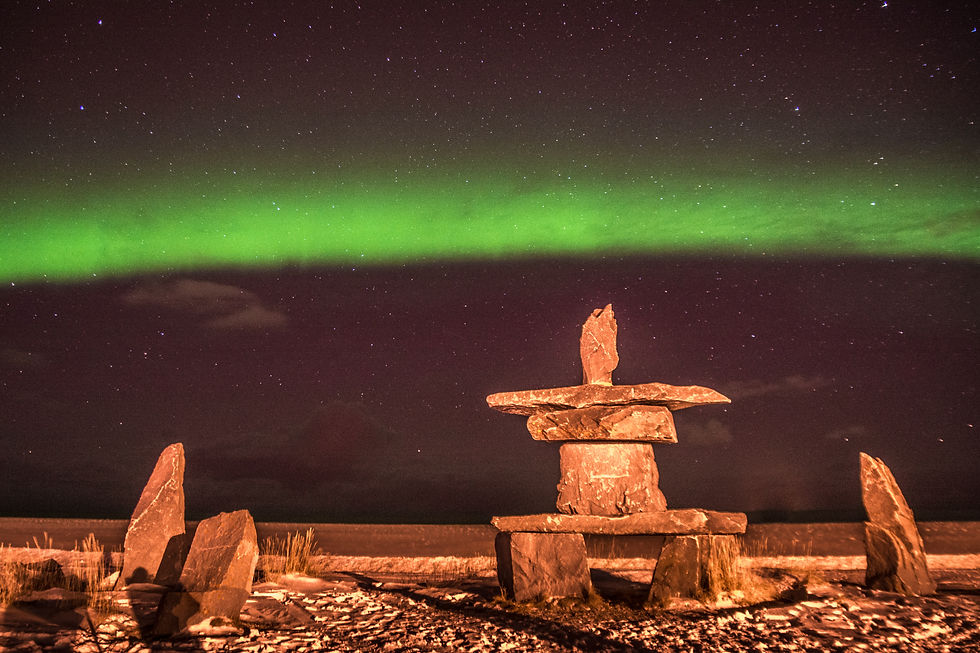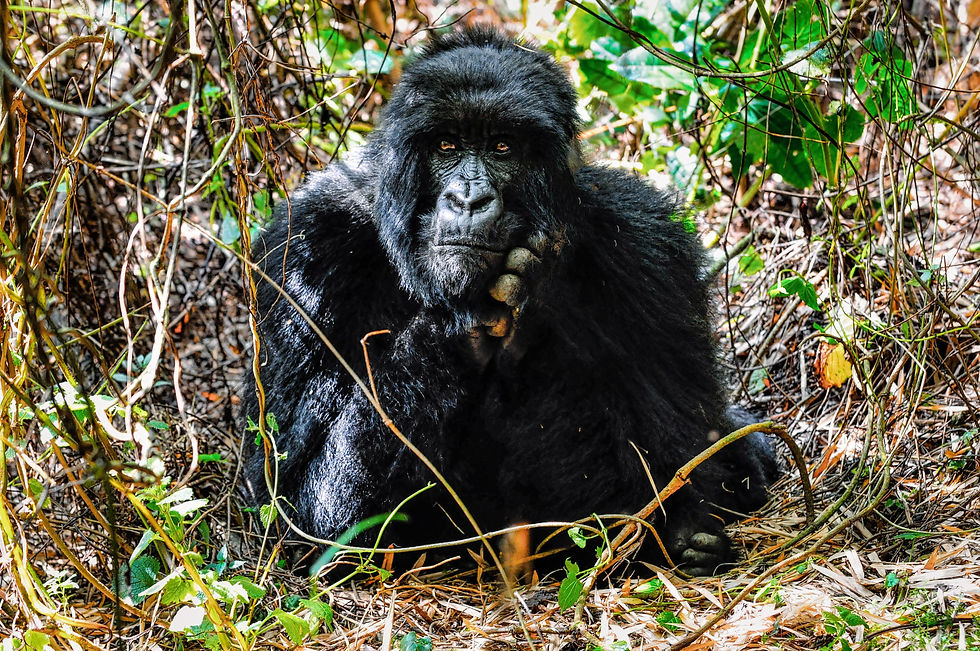Polar Bears
- Aaron & Clare

- 1. Nov. 2020
- 5 Min. Lesezeit
Aktualisiert: 8. Nov. 2020
An amazing encounter with the largest land carnivore
They look so cute and you wish you could cuddle them. But in contrast to brown bears, polar bear attacks are likely to be predatory and are almost always fatal. Victims are often unaware of the bear's presence until the attack is underway.

Churchill is located on the 58th parallel north on the shores of Canada's Hudson Bay and if you're lucky you can sometimes see the aurora borealis (Northern Lights) when there is a high amount of solar activity. Over two-thirds of the population is Indigenous and close to the shore you will find this rock formation called Innunguaq which means "in the likeness of a human.”

In 1717 the Hudson's Bay Company built the first permanent fur trading settlement a few kilometres upstream from the mouth of the Churchill River. Around 1930 a port was originally constructed for the export of Canadian grain to European markets, with rail-sea connections at Churchill. The storage building below was built in 1931 which indicates the size of grain that was transported to this port.

In summer, hundreds of beluga whales move into the warmer waters of the Churchill River estuary during July and August to calf. You can see foxes and polar foxes all year around. Our main reason to visit was to get up close to the polar bears. In 2013, we travelled to Churchill - the Polar Bear Capital. These beautiful white bears return to this area from the tundra around October, waiting for the ice to return which usually happens in November. By this time they are very hungry and in dire need to eat again to carry them through the next warmer season when the ice receeds again. As soon as the ice is about 10cm thick they can venture out and hunt for their main source of food: seals.

Adult polar bears live solitary lives. But in October, you can see young males play-fighting which can be seen as a preparation for serious competition during mating seasons later in life. To see them fighting is an amazing experience and gives you an idea of the power a fully grown male has when he grows to weigh around 350–700 kg.

A male may follow the tracks of a female for 100 km or more, and after finding her he will usually have to fight with other males over mating rights. This takes place on the sea ice in April and May and the intense fights often leave scars or broken teeth.

The polar bear is found in the Arctic Circle which includes the territory of five nations: Canada, United States (Alaska), Denmark (Greenland), Norway (Svalbard) and Russia. In this century five bears even swam to Iceland from Greenland. The longest recorded swimming distance was an unbelievable 354 kilometres!

As polar bears are very dangerous and excellent hunters the best way to observe them is by Polar Rovers. You can stand on a outdoor platform in the back and it is truly an amazing experience when seeing these huge beautiful animals walking just in front of you - almost soundlessly. They normally ignore these vehicles but occasionally they will get curious and wonder what's inside - so they come and have a look and sniff!

Polar bears actually spend far more time at sea than they do on land. They hunt seals from a platform of ice. The bear uses its excellent sense of smell to locate a seal breathing-hole and may lie in wait for several hours. When the seal exhales, the bear smells its breath, reaches into the hole with a forepaw, and drags it out onto the ice.

With the exception of pregnant females, polar bears do not hibernate any time of the year. In the area of Hudson Bay when sea ice is unavailable during summer and early autumn, the bears live off their fat reserves. But not only that: a scientist found that 71% of the Hudson Bay bears had fed on seaweed and 50% were feeding on birds and sea ducks. They were also diving to feed on mussels and sea urchin.

Although polar bears are quite flexible with their nutrition, seal remains the primary and an indispensable food source to ensure their survival. Since our trip we followed the ice map on the internet each year always in the hope that the ice will build up for them in early November. Unfortunately and very sadly, in recent years their return to their winter hunting ground has been delayed by the increasingly late ice formation caused by the extreme climate change.

Occaisionaly some bears will try to find food in town. There are rangers who work to shy them away but if they are too stubborn they have to be caught. They are then taken to a holding facility known as the 'polar bear jail'. Here they are held for up to 30 days without food - they are then drugged and helicoptered to an area safely away from Churchill and released there into the wilderness. It seems (and is!) awful, but in reality it is the only way to ensure they don't keep returning to town by giving them this experience - and therefore actually saving their lives.

During our trip something so very sad happened - as often is the case of innocent animals - it was caused by the stupidity of humans! It was Halloween night and three stupid people walked home from a party at 5 a.m. in the morning when they were attacked by a male bear. Two people were badly wounded but survived (lucky for them). The attacking bear was sadly killed. Very unfortunately, around the same time, a mother bear with her baby were also roaming around the outskirts of town. Because of the panic of the attack, the mother bear was shot by mistake. We had just seen these two lovely bears the day before - it was just awfully sad and shocking that this mother bear was killed. Her baby ended up in a zoo - all this just because some stupid idiots ignored some simple and basis rules.

It is on the Arctic ice that the polar bear survives, which is why global warming is such a serious threat to its well-being. In just 20 years the ice-free period in Hudson Bay has increased by an average of 20 days. As a result, polar bears are having problems building up sufficient fat reserves to survive the period of scarce food in the summer. The average bear weight has dropped by 15 percent, also causing reproduction rates to decline. Today, the Hudson Bay population is down more than 20 percent.

A study from a US scientist predicted that one-third of the world's polar bear population, which is about 20–25,000 worldwide, may disappear by 2050. We can only hope that he isn't right. And there is hope: In 1992, due to the eruption of Mount Pinatubo, the sunlight in the artic was blocked which reduced the temperature by 0.5% and as a result the ice free period at Hudson Bay was short. Polar bears were therefore well fed and fat. In 2020 with COVID-19 and global lockdown, the Hudson Bay region experienced the earliest ice formation since 1993. With the right actions, global warming could be stopped...

If you are interested in more research, these are a couple of good sites:
This is the first blog of our new series 'Amazing Wildlife Encounters'.
"One crowded hour of glorious life is worth an age without a name"
(The Call - Thomas Osbert Morsdaunt, 1730-1809)
© Aaron Matzinger & Clare Walker



Kommentare